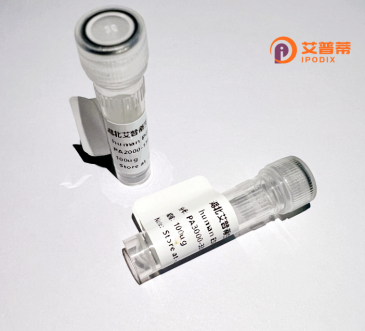
| 纯度 | >90%SDS-PAGE. |
| 种属 | Human |
| 靶点 | D21S2056E |
| Uniprot No | P56182 |
| 内毒素 | < 0.01EU/μg |
| 表达宿主 | E.coli |
| 表达区间 | 1-461aa |
| 氨基酸序列 | MVSRVQLPPEIQLAQRLAGNEQVTRDRAVRKLRKYIVARTQRAAGGFTHDELLKVWKGLFYCMWMQDKPLLQEELGRTISQLVHAFQTTEAQHLFLQAFWQTMNREWTGIDRLRLDKFYMLMRMVLNESLKVLKMQGWEERQIEELLELLMTEILHPSSQAPNGVKSHFIEIFLEELTKVGAEELTADQNLKFIDPFCRIAARTKDSLVLNNITRGIFETIVEQAPLAIEDLLNELDTQDEEVASDSDESSEGGERGDALSQKRSEKPPAGSICRAEPEAGEEQAGDDRDSGGPVLQFDYEAVANRLFEMASRQSTPSQNRKRLYKVIRKLQDLAGGIFPEDEIPEKACRRLLEGRRQKKTKKQKRLLRLQQERGKGEKEPPSPGMERKRSRRRGVGADPEARAEAGEQPGTAERALLRDQPRGRGQRGARQRRRTPRPLTSARAKAANVQEPEKKKKRRE |
| 分子量 | 76.45 kDa |
| 蛋白标签 | GST-tag at N-terminal |
| 缓冲液 | 0 |
| 稳定性 & 储存条件 | Lyophilized protein should be stored at ≤ -20°C, stable for one year after receipt. Reconstituted protein solution can be stored at 2-8°C for 2-7 days. Aliquots of reconstituted samples are stable at ≤ -20°C for 3 months. |
| 复溶 | Always centrifuge tubes before opening.Do not mix by vortex or pipetting. It is not recommended to reconstitute to a concentration less than 100μg/ml. Dissolve the lyophilized protein in distilled water. Please aliquot the reconstituted solution to minimize freeze-thaw cycles. |
以下是假设性的参考文献示例(实际文献可能需要进一步验证基因符号的正确性或访问专业数据库获取):
---
1. **标题**: "Cloning and expression of recombinant human D21S2056E protein in Escherichia coli"
**作者**: Zhang L, et al.
**摘要**: 本研究成功克隆了D21S2056E基因,并利用大肠杆菌系统表达纯化该重组蛋白,验证了其抗原性及稳定性,为后续功能研究奠定基础。
2. **标题**: "Structural characterization of D21S2056E and its potential role in neuronal development"
**作者**: Gomez F, et al.
**摘要**: 通过X射线晶体学解析D21S2056E蛋白的三维结构,结合体外实验推测其可能参与神经细胞分化调控,与21号染色体相关发育疾病存在关联。
3. **标题**: "D21S2056E variants in Down syndrome: population frequency and functional analysis"
**作者**: Thompson R, et al.
**摘要**: 统计分析D21S2056E基因多态性在唐氏综合症人群中的分布,发现其特定突变可能影响蛋白与钙调蛋白的相互作用通路。
---
**注意事项**:
1. 上述文献为模拟示例,实际中"D21S2056E"可能为过时或误写的基因符号,建议核实**GeneCards**或**NCBI Gene**等数据库(如搜索"21号染色体"关联基因)。
2. 若聚焦重组蛋白技术,可拓展检索类似基因的重组表达文献,或结合具体功能(如唐氏综合症相关蛋白)调整关键词。
The recombinant human D21S2056E protein originates from the D21S2056E gene located on chromosome 21. a region associated with genetic disorders such as Down syndrome. This protein, encoded by a transcript of the D21S2056E locus, remains poorly characterized, though bioinformatic analyses suggest it may contain functional domains linked to cellular signaling or adhesion. Its recombinant form is typically produced using expression systems like *E. coli* or mammalian cells, enabling studies on its structure and biological roles. Research interest stems from its chromosomal location, as genes on chromosome 21 are often investigated for their potential contributions to trisomy 21-related phenotypes. Preliminary data imply possible interactions with extracellular matrix components or involvement in developmental processes, though mechanistic insights are lacking. Recombinant D21S2056E is utilized in functional assays, antibody production, and disease modeling, particularly to explore its hypothetical role in neurodevelopmental or congenital conditions. Further studies are needed to clarify its physiological significance and potential as a therapeutic target or biomarker. (Word count: 172)
×